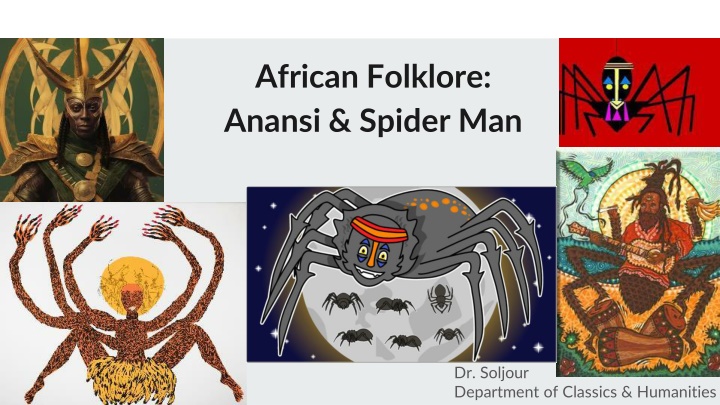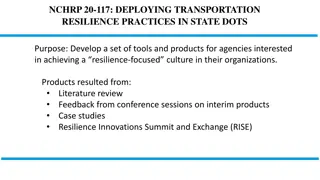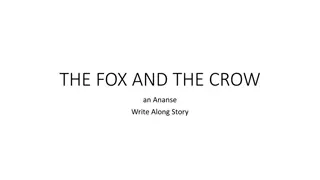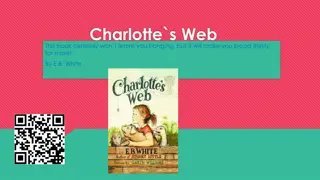Anansi the Spider: A Tale of Trickery and Resilience
Anansi the Spider, originating from Ghana, is a prominent figure in West African folklore known for his cunning and ability to outsmart more powerful adversaries. This tale explores Anansi's role as a trickster and his significance in the African diaspora, particularly in Jamaica. Through oral and written traditions, Anansi's stories have been transmitted across generations, showcasing themes of resilience and cleverness in overcoming challenges.
Download Presentation

Please find below an Image/Link to download the presentation.
The content on the website is provided AS IS for your information and personal use only. It may not be sold, licensed, or shared on other websites without obtaining consent from the author.If you encounter any issues during the download, it is possible that the publisher has removed the file from their server.
You are allowed to download the files provided on this website for personal or commercial use, subject to the condition that they are used lawfully. All files are the property of their respective owners.
The content on the website is provided AS IS for your information and personal use only. It may not be sold, licensed, or shared on other websites without obtaining consent from the author.
E N D
Presentation Transcript
African Folklore: Anansi & Spider Man Dr. Soljour Department of Classics & Humanities
Introductions Lecture Oral and written transmission of stories in African Culture History of Anansi the Spider The Transatlantic Slave Trade The Legacy of Anansi in the New World Overview
Who is Anansi the Spider? Originating in Ghana, Anansi is the Akan word for spider. He is one of the most important characters in West African, African American and West Indian folklore. Anansi is depicted in many ways with different names. Such as: Kwaku Ananse, Anancy, Kompa Nanzi, Nancy, Aunt Nancy and Sis' Nancy. Anansi is best known for his ability to outsmart and triumph over more powerful opponents.
How the Word Was Passed. Oral tradition or storytelling: often accompanied by ceremony and performance. Community transmission: these stories, songs, and ceremonies were often retold and performed over generations. Written transmission: the process of oral stories becoming written literature was facilitated by scholars and practitioners inside and outside of the communities of origin. Griot: is a West African historian, storyteller, praise singer, poet, and/or musician that relies on the oral tradition. (Sierra Leone, 17th century) Modern Day Griot: Dr. Arthur Flowers
Anansi: The Trickster Trickster Characteristics! The trickster is usually the protagonist. They usually cause problems for the other characters in the story. They usually go unpunished They usually take on animal form Leuk, Rabbit (Senegal) Bouki, Hyena (Senegal/Louisiana) Anansi, Spider (Ghana/Caribbean)
Anansi & the African Diaspora Between the 15th -19th century, an estimated 12-15 million African people were enslaved and forcefully displaced. Displaced Africans were relocated to North and South America, Europe and the Caribbean. As a result of the transatlantic slave trade, we have the creation of an African Diaspora. Diaspora: the forced movement, forced migration and the scattering of a group of people from their ancestral homeland.
Anansi & the African Diaspora: Jamaica The myth of Anansi, the trickster spider - Emily Zobel Marshall Follow the spider Anansi on his quest to complete a challenge from the Sky God in order to take ownership of the world s stories. -- Long ago, all stories belonged to Nyame, the all-seeing Sky God. But one creature, Anansi, was determined to bring the stories down to Earth. Anansi went to Nyame and requested to take ownership of the world s stories. The Sky God told Anansi that he could have all the stories he wished but only if he could complete an impossible task. Emily Zobel Marshall shares the cunning spider's journey. Lesson by Emily Zobel Marshall, directed by Keegan Thornhill. Support Our Non-Profit Mission ---------------------------------------------- Support us on Patreon: http://bit.ly/TEDEdPatreon Check out our merch: http://bit.ly/TEDEDShop ---------------------------------------------- Connect With Us ---------------------------------------------- Sign up for our newsletter: http://bit.ly/TEDEdNewsletter Follow us on Facebook: http://bit.ly/TEDEdFacebook Find us on Twitter: http://bit.ly/TEDEdTwitter Peep us on Instagram: http://bit.ly/TEDEdInstagram ---------------------------------------------- Keep Learning ---------------------------------------------- View full lesson: https://ed.ted.com/lessons/the-myth-of-anansi-the-trickster-spider-emily-zobel-marshall Dig deeper with additional resources: https://ed.ted.com/lessons/the-myth-of-anansi-the-trickster-spider-emily-zobel-marshall#digdeeper Animator's website: https://www.behance.net/cosmiconionring ---------------------------------------------- Anansi is best known for his ability to outsmart and triumph over more powerful opponents. He became a symbol of slave resistance/survival and provided a sense of continuity with an African past. Thank you so much to our patrons for your support! Without you this video would not be possible! zjweele13, Jurjen Geleijn, Anna-Pitschna Kunz, Edla Paniguel, Thomas Mungavan, Jaron Blackburn, Venkat Venkatakrishnan, ReuniteKorea, Aaron Henson, Rohan Gupta, Begum Tutuncu, Mikhail Shkirev, Brian Richards, Cindy O., J rgen sterpart, Tyron Jung, Carolyn Corwin, Carsten Tobehn, Katie Dean, Ezgi Yersu, Gerald Onyango, alessandra tasso, C me Vincent, Doreen Reynolds-Consolati, Manognya Chakrapani, Ayala Ron, Samantha Chow, Eunsun Kim, Phyllis Dubrow, Ophelia Gibson Best, Paul Schneider, Joichiro Yamada, Henrique Cass s, Lyn-z Schulte, Elaine Fitzpatrick, Karthik Cherala, Clarence E. Harper Jr., Brad Sullivan, Karen Ho, Vignan Velivela, Ana Maria, Exal Enrique Cisneros Tuch, Tejas Dc, Khalifa Alhulail, Martin Stephen, Dan Paterniti, Jose Henrique Leopoldo e Silva, Elnathan Joshua Bangayan, Jayant Sahewal, Mandeep Singh, Abhijit Kiran Valluri and Kris Siverhus. **Pay close attention to how the story explains the role of Anansi **
Anansi & the African Diaspora: Haitis Ti-Malice and Bouki Ti Malice is a trickster figure in Haitian folklore. He is cunning and clever, but lazy. (Ton-Ton) Bouki is greedy and dim- witted, but hardworking. The stories of Ti Malice and Uncle Bouki were primarily passed down in oral tales and some originate from Anansi. His characteristics were divided between the two animals (the rabbit and the hyena). Ti Malice (The Rabbit) Bouki (The Hyena) Sos Ti Malice
Anansi & the African Diaspora: Br'er Rabbit in the American South Br'er Rabbit (an abbreviation of Brother Rabbit) is a central trickster figure in oral traditions passed down by African- Americans in the American South. Adaptations of Br er Rabbit reached new and popular audiences through the authorship of Joel Harris. Harris created the character Uncle Remis Remis is used as a griot-like figure that shares versions of Anansi tales often with unfruitful endings. The most famous of the Anansi stories adapted by Remus is Tar Baby. Joel Harris was an American journalist amd fiction writer, best known for creating the character Uncle Remus.
Anansi in Contemporary Media Disney s Depiction of Br er Rabbit & Tar Baby in Song of the South (1946). Ossie Davis (1917-2005) voiced a recurring Sesame Street animated segment as the voice of Anansi the Spider in 1996. Kwaku Anansi (Earth-616) is a character within Marvel s multiverse identified as the first Spiderman character in 2002-2003.























